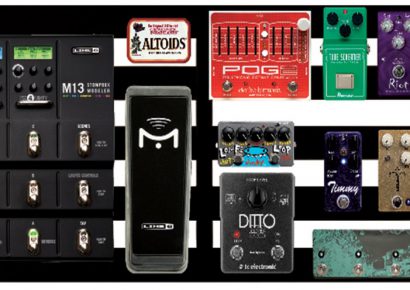The company's President tells us about what's in store for the brand in their third decade of operation.
Some gear companies shoot for financial success – Pedaltrain, on the other hand, simply aim to change the game.
For over 20 years, the Nashville-based firm have singlehandedly changed the way musicians approach their pedalboards, with their range of rugged and versatile floorboards proving to be a one-brand revolution among pedal-heads.
As they enter their third decade of operation, we catch up with Pedaltrain President Jim Colella for a chat about their modus operandi, what they look for in products and what’s next for the company.
Never miss an update – sign up to our newsletter for all the latest news, reviews, features and giveaways.
Take us back to the early days of Pedaltrain. How did the company come about in the first place?
Greetings from Nashville, Tennessee. Before we get started, I would like to say thank you to all of the musicians in Australia who have been so kind and welcoming to Pedaltrain, from the very beginning. Also, you have some of the best guitar shops in the world!
These shops have always supported Pedaltrain, and we are grateful. We are so humbled and grateful that you find Pedaltrain products useful and durable. We love seeing your social media posts and are truly overjoyed by your friendship. When this pandemic stuff is behind us, we will come visit and throw a big party!
Now on to the story…
Prior to founding Pedaltrain in 1999, John Chandler was a professional guitar technician based out of Nashville, Tennessee. As you know, Nashville is home to many professional touring entertainers.
His clients included numerous Grammy Award-nominated artists with album sales certified by Soundscan and RIAA in excess of one million albums (Platinum).
View this post on Instagram
His clients performed in front of hundreds of thousands of fans annually in some of the most prestigious and recognized venues around the world. Each night, when his clients took the stage, their instruments and supporting equipment had to be in perfect working order. This was John’s job.
When not on the road, John worked for a commercial awning company, installing awnings at restaurants and shopping malls. Extruded aluminium frames supported these awnings. John wondered if these extruded aluminum pieces could be arranged to support guitar effects pedals, and solve the problem his pro touring friends were having.
John borrowed a specialized welder, got to tinkering in the garage and made some prototypes. Word spread very quickly in Nashville. Pedaltrain was born!
What was the guitar effects floorboard sector like when you entered the market? How did you guys nail what seems to be such a utilitarian product and come to dominate the sector?
The only real pedalboards, if you can call them that, were custom-made switching systems.
This solution was only available to wealthy professionals. There wasn’t much in terms of a budget-friendly solution, and certainly nothing that allowed cables to be routed through the mounting surface. Back then, many Nashville pros used flat pieces of plywood and screws.
Our founder knew the rigors of professional touring travel (energetic performances, trucking, airline baggage handling, frequent set-up and tear down) caused frequent equipment failures.
Guitar effects pedals and their associated audio and power cabling were the most susceptible to damage and mishandling, both at the hands (or feet as it were) of the energized performers and those people responsible for transporting the equipment between venues.
In the 1990s, one of the primary duties of a guitar technician was to repair and rebuild these guitar effects pedals in time for each night’s performance. Invariably, cables would be torn loose, sockets of pedals would be bent, the pedals would be torn loose from plywood mounting boards, and knobs would be damaged.
This was the genesis of our idea for Pedaltrain, and what got John working in his garage.
View this post on Instagram
How has Pedaltrain evolved over the past twenty years to keep up with the many needs of musicians who use your products?
First, we always listen to our customers. We talk directly to real musicians. Not in contrived ‘marketing focus groups’, either. We actively talk to active Pedaltrain users at shows, backstage, in stores, online etc.
We talk to musicians that are very famous and those that are just starting out. Everyone has a voice. If you are ever in a Nashville guitar shop and some guy walks up and starts asking you about pedals, pedalboards, cases, etc… It is probably me!
More to the point about listening, I personally read and review every single customer service email that we receive from around the world. This ensures that we have great customer service, of course. But it also tells me what is on people’s minds and helps me anticipate changes in trends.
This leads me to the second way we evolve: iteration. Pedaltrain products are always changing. Sometimes in visible ways, sometimes in ways only I notice. Either way, we are relentlessly improving.
Consider that we started with one model and today we offer over 35 models and case combinations. We have quietly revised our soft case design 15 times in the last five years.
We are always making it better. Better materials, better zippers, deeper, better shoulder straps… Always relentlessly better. The Pedaltrain you buy in 2021 is by far the best Pedaltrain product we have ever made.
Third, we are very self-critical. The standard we hold for our products demands excellence and we are ruthlessly committed to achieving it. We do not cut corners, ever. We do not use cheaper materials or processes.
We do not use inferior construction techniques like bent, rolled and stamped metals. We do not attach critical components with screws and the like. Everything is handmade, hand cut and hand welded.
Lastly, I consider larger needs. For me, it is not enough to simply make great products. The way the products are made is very important. We protect our environment. We have implemented state of the art air filtration and eco-friendly manufacturing processes. We strive for five-nines recycling (99.999%) of waste. We use very little plastic in our products and packaging.
All of this is intentional and I am driven to be a good steward of our world’s resources. Similarly, the way we meet the needs of the less fortunate is also important. We give generously to charity via our HOOK LOOP LOVE line of products.
You simply cannot buy a better made pedalboard anywhere in the world.
View this post on Instagram
Something we’ve never encountered another accessories brand do before is the Pedalboard Planner website, which lets users virtually lay out their signal chain on an imagined board. Tell us about how that came about, and how players can use it to their advantage.
Thanks for noticing. PedalboardPlanner.com was born almost 13 years ago by a friend of our company. He was working on a computer code project and built the first generation of the website for that purpose. We became close friends and then I bought the website from him.
Since then we have added 3000 pedals from 300 brands. We also have an iOS and Android app that is free to download. You can find them here.
Our friends who make pedals are so creative and prolific that it is hard to keep up with all the new designs and models, but we do our best!
View this post on Instagram
Finally, what’s over the horizon for Pedaltrain in 2021 and beyond?
In addition to the constant improvement of our current products, we have a full pipeline of products in the queue. I can’t wait for you to hear them (hint hint).
Thanks again for this opportunity. And thanks to all of the musicians and stores in Australia for your many years of friendship.
Head to Pedaltrain to check out their product range in full today. For local enquiries, get in touch with Pedaltrain’s domestic distributor, EGM Distribution.







